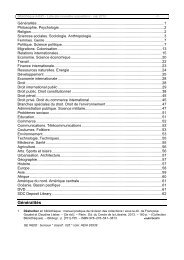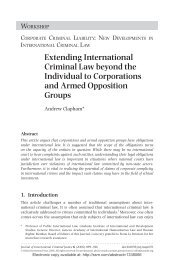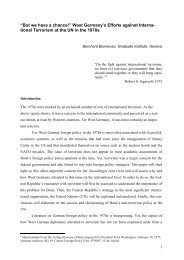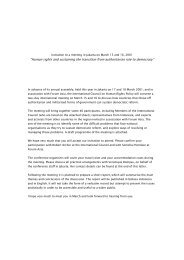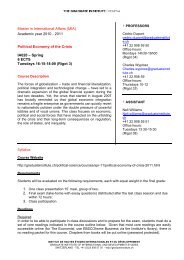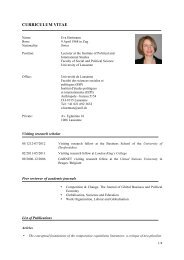The 1953 Coup D'etat in Iran Author(s): Mark J. Gasiorowski Source ...
The 1953 Coup D'etat in Iran Author(s): Mark J. Gasiorowski Source ...
The 1953 Coup D'etat in Iran Author(s): Mark J. Gasiorowski Source ...
You also want an ePaper? Increase the reach of your titles
YUMPU automatically turns print PDFs into web optimized ePapers that Google loves.
<strong>The</strong> <strong>1953</strong> <strong>Coup</strong> D'Etat <strong>in</strong> <strong>Iran</strong> 279<br />
bazaar and at Tehran University were broken up. A successor to the National<br />
Front known as the National Resistance Movement was suppressed. <strong>The</strong> Qashqai<br />
tribe was attacked and its leaders were sent <strong>in</strong>to exile. Press censorship was<br />
<strong>in</strong>stituted. A secret police force was established that soon evolved <strong>in</strong>to the<br />
notorious SAVAK. Majlis elections <strong>in</strong> February 1954 were blatantly rigged.79<br />
Except dur<strong>in</strong>g a brief period <strong>in</strong> the early 1960s, the <strong>in</strong>struments of dictatorship<br />
were kept firmly <strong>in</strong> place until the <strong>Iran</strong>ian revolution began to unfold <strong>in</strong> 1978. By<br />
then, any hope of establish<strong>in</strong>g a democratic alternative to the Shah had long<br />
s<strong>in</strong>ce been lost.<br />
<strong>The</strong> <strong>1953</strong> coup was thus a decisive turn<strong>in</strong>g po<strong>in</strong>t <strong>in</strong> <strong>Iran</strong>ian history. Had the<br />
coup not occurred, <strong>Iran</strong>'s future would undoubtedly have been vastly different.<br />
Similarly, the U.S. role <strong>in</strong> the coup and <strong>in</strong> the subsequent consolidation of the<br />
Shah's dictatorship were decisive for the future of U.S. relations with <strong>Iran</strong>. U.S.<br />
complicity <strong>in</strong> these events figured prom<strong>in</strong>ently <strong>in</strong> the terrorist attacks on American<br />
citizens and <strong>in</strong>stallations that occurred <strong>in</strong> <strong>Iran</strong> <strong>in</strong> the early 1970s, <strong>in</strong> the anti-<br />
American character of the 1978-1979 revolution, and <strong>in</strong> the many anti-American<br />
<strong>in</strong>cidents that emanated from <strong>Iran</strong> after the revolution, <strong>in</strong>clud<strong>in</strong>g, most notably,<br />
the embassy hostage crisis. Latter-day supporters of the coup frequently argue<br />
that it purchased twenty-five years of stability <strong>in</strong> <strong>Iran</strong> under a pro-American<br />
regime. As the dire consequences of the revolution for U.S. <strong>in</strong>terests cont<strong>in</strong>ue to<br />
unfold, one can only wonder whether this has been worth the long-term cost.<br />
DEPARTMENT OF POLITICAL SCIENCE<br />
LOUISIANA STATE UNIVERSITY<br />
NOTES<br />
<strong>Author</strong>'s note: I would like to thank Peter Avery, Edward Azar, Carol Bargeron, Richard Cottam,<br />
Fred Halliday, Homa Katouzian, Nikki Keddie, Hedayat Mat<strong>in</strong>-Daftari, Nasser Pakdaman, Bill<br />
Royce, Khosrow Shakeri, and several people who must rema<strong>in</strong> unnamed for their valuable assistance<br />
and for comments on earlier drafts of this paper.<br />
'Kermit Roosevelt, the leader of the coup, was asked to undertake similar operations aga<strong>in</strong>st<br />
Arbenz <strong>in</strong> Guatemala and Nasser <strong>in</strong> Egypt. See <strong>The</strong> Los Angeles Times, March 29, 1979, 5-8. At<br />
least one participant <strong>in</strong> the coup went on to achieve considerable notoriety with similar operations <strong>in</strong><br />
Syria, Nepal, and Vietnam. See <strong>The</strong> Wall Street Journal, October 19, 1979, p. 1. No less an authority<br />
than Richard Helms, CIA director from 1965 until 1973, described the <strong>1953</strong> coup to me as an<br />
important model for CIA covert operations elsewhere (telephone <strong>in</strong>terview, Wash<strong>in</strong>gton, D.C., July<br />
26, 1984).<br />
2Kermit Roosevelt, Countercoup (New York: McGraw-Hill, 1979). For a good discussion of the<br />
flaws <strong>in</strong> this account see the reviews by Richard Cottam, <strong>in</strong> <strong>Iran</strong>ian Studies, 14, 3-4 (Summer-<br />
Autumn 1981), 269-72, and Thomas Powers, <strong>in</strong> <strong>The</strong> Nation, April 12, 1980, 437-40. <strong>The</strong> first public<br />
account of the coup <strong>in</strong> the American press was leaked by the CIA dur<strong>in</strong>g the 1954 U.S. elections. See<br />
Richard and Gladys Harkness, "<strong>The</strong> Mysterious Do<strong>in</strong>gs of CIA," Saturday Even<strong>in</strong>g Post, November<br />
6, 1954, 66-68. Incomplete accounts are also given by Andrew Tully, CIA, the Inside Story (New<br />
York: Morrow, 1962), ch. 7; Barry Rub<strong>in</strong>, Paved With Good Intentions (New York: Oxford<br />
University Press, 1980), pp. 77-88; Christopher Montague Woodhouse, Someth<strong>in</strong>g Ventured (Lon-<br />
don: Granada, 1982), chs. 8-9; Sepehr Zabih, <strong>The</strong> Mosaddeq Era (Chicago: Lake View Press, 1982),<br />
ch. 8; and Jonathon Kwitney, Endless Enemies (New York: Congdon & Weed, 1984), ch. 10. Each of


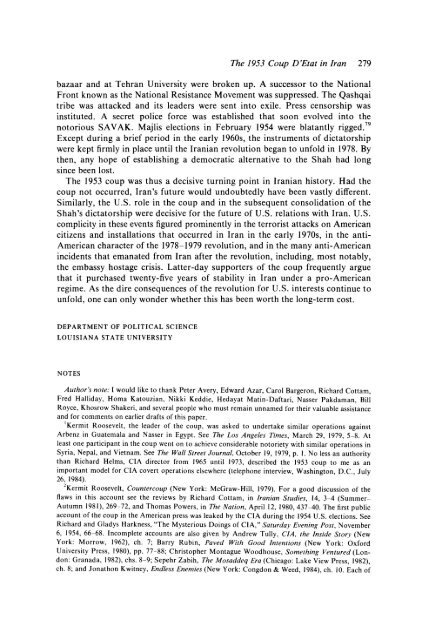
![Download [pdf] - The Graduate Institute, Geneva](https://img.yumpu.com/23370020/1/190x248/download-pdf-the-graduate-institute-geneva.jpg?quality=85)
